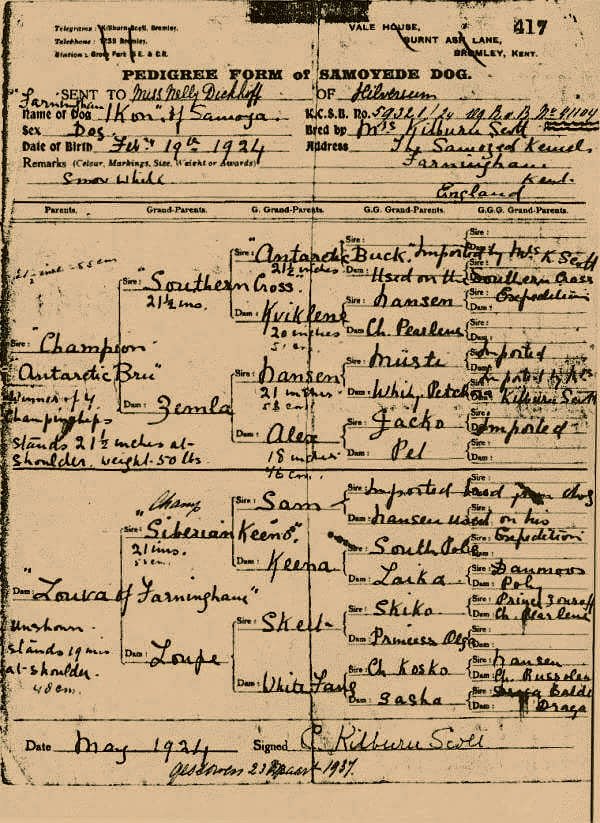HISTORY
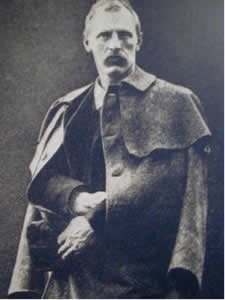
Nansen was the forerunner of the first polar expedition in Norway. He achieved with success the scientific feat and human approach to the North Pole, more than anyone else so far.
Many breeds have actively participated in the history of human civilizations. Each race has contributed in some historical periods of humanity with one or more particular functions. Many dogs served as transportation, guard dog, hunters, shepherds, some were worshiped as gods, others killed in revolutions, and many traveled the world in The Age of Exploration, suffered from wars and fought in them. The history of the domestic dog is our history and seen from another point of view.
In Egypt the dogs were revered as knowledgeable of the secrets of another world, the ancient Greeks compared their dogs to the greyhounds of today like the gods of healing. There were temples that housed dozens of dogs, so the wounded could be taken there and have his wounds licked by dogs. Homer himself said in one of his works: "Woe to the man who does not have a dog to lick his wounds ...."
Samoyeds such as the Saluki and Hound Pharaoh are some of oldest races that have existed. We really do not know which one is the oldest, but all have about 5,000 years of existence.
While revolutions happened across Europe and Asia, in Siberia, nomadic tribes kept their lifestyle for several generations. The Samoyeds tribe used their dogs (that later would receive the name of Samoyed) for almost everything and hardly survive in the inhospitable conditions of Siberia without them. These were the dogs, brought from Siberia, which made possible the conquest of the Pole by the explorers like Norwegian Roald Amundsen and the North American Robert Peary. The first men to walk on the South Pole and North Pole, respectively, reached there sled by Samoyeds.
It is believed that the Samoyeds had the starting point at the beginning of the prehistoric period. In Siberia, nomadic families of Mongolian origin began to move in all directions for reasons of conflict with people located further south, or in search of another condition of life. Followed by their dogs, some of these people, directed to the Arctic, for about 1000 years BC, inhabited the entire coastal area, starting from the White Sea to the Taimyr Peninsula and inland to the Yenisei River.
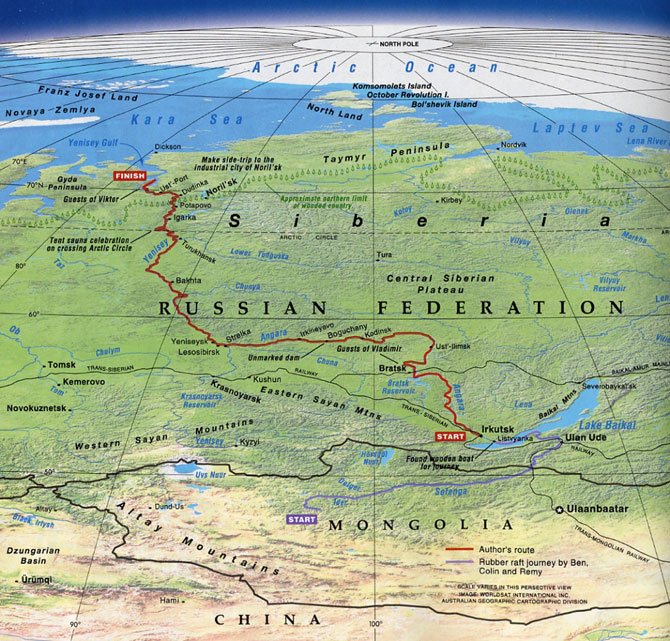
These nomads had the characteristic of being short (approximate measurements of 145cm for men and 130cm for women), dark yellow skin, cheekbones highlighted, but these people eventually became known for two reasons in particular: their dogs and how they treated them!
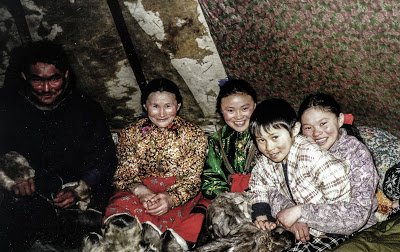
This tribe of kind and sociable people treated the dogs as members of their family. They never abused of them, the dogs were trained to voice commands, allowed them to walk into their homes (chooms) and even in places where they slept, where they ended up being true heaters alive. They used them in the hunt in general, in grazing and escorting herds of reindeer (caribou), transportation, pulling sleds, where there was a job for each dog according to their age and physical condition.
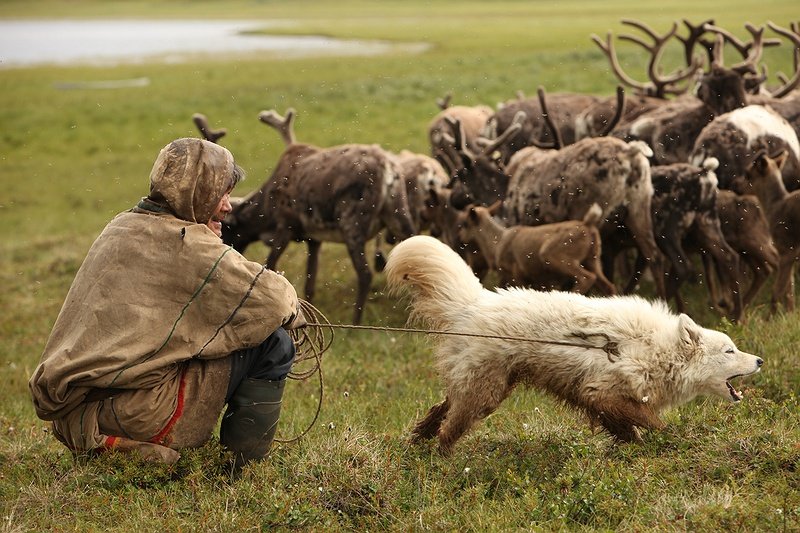
When the dog was larger, they were used to pull sleds, hunting, others in the conduct of livestock and also had those who were used to guard the camp, and even play with the children. Respect for their dogs was so great that it precluded the work the older and pregnant female dogs.
Thus, these tribes have created in their dogs, link of worship, trust and respect for human beings of pure eternity!
Note: Bjelkier was the name that was called a Samoyed by tribes of Samoyeds. Meaning: "white dog that breeds white."
The Russians in the 18th century began the exploration of Siberia and thus realize the attributes of Bjelkiers. Their grandeur and personality captivated the Tsar's family who was in charge of the protection to foreigners, allowing a very rare copy Samoyed was offered to any member of the European nobility. Not long before they notice their very useful for pulling the sleds of tax collectors and explorers.
In Egypt the dogs were revered as knowledgeable of the secrets of another world, the ancient Greeks compared their dogs to the greyhounds of today like the gods of healing. There were temples that housed dozens of dogs, so the wounded could be taken there and have his wounds licked by dogs. Homer himself said in one of his works: "Woe to the man who does not have a dog to lick his wounds ...."
Samoyeds such as the Saluki and Hound Pharaoh are some of oldest races that have existed. We really do not know which one is the oldest, but all have about 5,000 years of existence.
While revolutions happened across Europe and Asia, in Siberia, nomadic tribes kept their lifestyle for several generations. The Samoyeds tribe used their dogs (that later would receive the name of Samoyed) for almost everything and hardly survive in the inhospitable conditions of Siberia without them. These were the dogs, brought from Siberia, which made possible the conquest of the Pole by the explorers like Norwegian Roald Amundsen and the North American Robert Peary. The first men to walk on the South Pole and North Pole, respectively, reached there sled by Samoyeds.
It is believed that the Samoyeds had the starting point at the beginning of the prehistoric period. In Siberia, nomadic families of Mongolian origin began to move in all directions for reasons of conflict with people located further south, or in search of another condition of life. Followed by their dogs, some of these people, directed to the Arctic, for about 1000 years BC, inhabited the entire coastal area, starting from the White Sea to the Taimyr Peninsula and inland to the Yenisei River.

These nomads had the characteristic of being short (approximate measurements of 145cm for men and 130cm for women), dark yellow skin, cheekbones highlighted, but these people eventually became known for two reasons in particular: their dogs and how they treated them!

This tribe of kind and sociable people treated the dogs as members of their family. They never abused of them, the dogs were trained to voice commands, allowed them to walk into their homes (chooms) and even in places where they slept, where they ended up being true heaters alive. They used them in the hunt in general, in grazing and escorting herds of reindeer (caribou), transportation, pulling sleds, where there was a job for each dog according to their age and physical condition.

When the dog was larger, they were used to pull sleds, hunting, others in the conduct of livestock and also had those who were used to guard the camp, and even play with the children. Respect for their dogs was so great that it precluded the work the older and pregnant female dogs.
Thus, these tribes have created in their dogs, link of worship, trust and respect for human beings of pure eternity!
Note: Bjelkier was the name that was called a Samoyed by tribes of Samoyeds. Meaning: "white dog that breeds white."
The Russians in the 18th century began the exploration of Siberia and thus realize the attributes of Bjelkiers. Their grandeur and personality captivated the Tsar's family who was in charge of the protection to foreigners, allowing a very rare copy Samoyed was offered to any member of the European nobility. Not long before they notice their very useful for pulling the sleds of tax collectors and explorers.
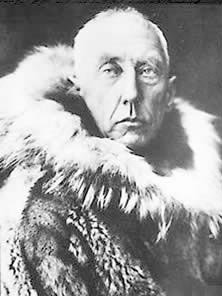
Roald Engelbregt Gravning Amundsen (¤ 16.07.1872 - † 22.06.1928)
Fridtjof Wedel-Jarlsberg Nansen (10.10.1861 - 05.13.1930) was a scientist, politician, adventurer and polar explorer. Academic and Norwegian humanist he has helped the Samoyed breed. On his first expedition Nansen chose and led Bjelkiers. These dogs had an extreme reputation among the Nordic, not only by their physical size, but also for their astronomical worship to the people.
Nansen took 40 dogs from a group of Asian nomadic that created them perhaps over thousands of years through Alexander Tronttheim from Russian origin who was responsible for getting the Bjelkiers to Czar´s family. The nomads were known as "Samoyedes" name given by the Russians because of the situation of isolation which means "self-sufficient."
Because of the extreme and difficult conditions in 1895 Nansen in the company of Fredrik Hjalmar Johansen with skis, snowshoes, sleds pulled by Bjelkiers and kayak, reached about 350 km from the North Pole. Although they had not been successful in their adventure they managed a feat not yet achieved by another man.
The heroic and unparalleled behavior of Bjelkiers was reported to other explorers by Nansen who had great influence on other expeditions that undoubtedly influenced many of the expeditions to the Arctic and Antarctic continents.
The American explorers Fiala and Baldwin also used the Bjelkiers in their expeditions.
A real example was Roald Amundsen who was the winner in the race to conquer the South Pole.
On December 14, 1911, the Norwegian flag was raised at the South Pole. The Norwegian team had crossed the dangerous Ross Barrier to reach the foot of a high mountain range interlaced with glaciers. Further progress seemed hazardous. But due to their capabilities and dogs Bjelkiers, they forced their way up the Heiberg Glacier, crossed the mountain and reached the plateau which led to the Pole.
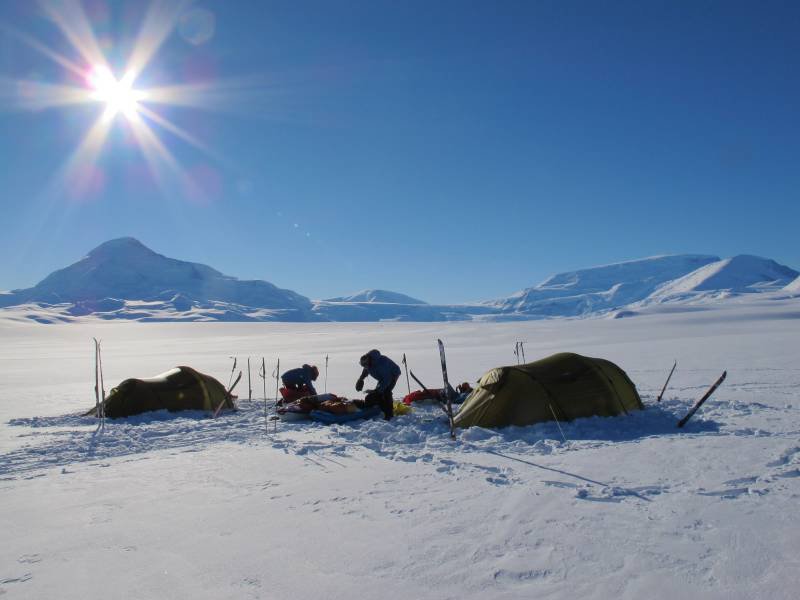
Nansen took 40 dogs from a group of Asian nomadic that created them perhaps over thousands of years through Alexander Tronttheim from Russian origin who was responsible for getting the Bjelkiers to Czar´s family. The nomads were known as "Samoyedes" name given by the Russians because of the situation of isolation which means "self-sufficient."
Because of the extreme and difficult conditions in 1895 Nansen in the company of Fredrik Hjalmar Johansen with skis, snowshoes, sleds pulled by Bjelkiers and kayak, reached about 350 km from the North Pole. Although they had not been successful in their adventure they managed a feat not yet achieved by another man.
The heroic and unparalleled behavior of Bjelkiers was reported to other explorers by Nansen who had great influence on other expeditions that undoubtedly influenced many of the expeditions to the Arctic and Antarctic continents.
The American explorers Fiala and Baldwin also used the Bjelkiers in their expeditions.
A real example was Roald Amundsen who was the winner in the race to conquer the South Pole.
On December 14, 1911, the Norwegian flag was raised at the South Pole. The Norwegian team had crossed the dangerous Ross Barrier to reach the foot of a high mountain range interlaced with glaciers. Further progress seemed hazardous. But due to their capabilities and dogs Bjelkiers, they forced their way up the Heiberg Glacier, crossed the mountain and reached the plateau which led to the Pole.

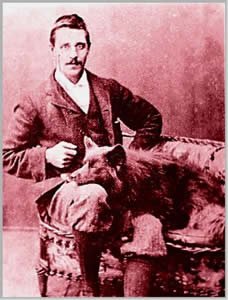
Ernest Kilburn Scott and Sabarka
The team leader Bjelkier, the female dog named Etah, was the first animal to reach the South Pole on December 14, 1911. A total of 52 dogs used, only 12 of them survived.
But behind such glory of Bjelkiers there was a cruelty of extreme brutality! Many dogs have died due to procedures of the explorers. They practiced the cannibalism, sacrificing the weak to feed the strongest, and also cutting their tail fur which served as the air filter while the dogs slept, causing pneumonia shortly.
These dogs with injuries often caused by frost, hungry, at no time left to exercise their duties on the expeditions, often donated their lives because of the success of man. And for all that, they are not honored as they should, many times the credit is given to those who did for much less. The expedition of 1895 sent by Nansen any of the dogs survived.
Among dogs used to exploit the Arctic only few of them resisted. Some were taken to countries of origin brought by the explorers. Others were used again in other holdings. Some were also taken to zoos.
The English scientist named Ernest Kilburn-Scott was the major contributor and responsible for the presentation and dissemination of race in the Western Hemisphere. This scientist was a zoologist and member of the Royal Zoological Society, so he made a series of trips all over the place of origin of these dogs, living with them in harsh climatic conditions, where you can watch them.
When Kilburn-Scott made one of his trips in 1889 to Archangel area, he was about 1450 kilometers to the west side of the Olenek river living with the inhabitants of this region, he faced and was enchanted by a dog which was on the verge of death where it would be sacrificed in a religious ritual. After intense negotiations with the chief of the tribe he persuaded him to exchange his sleigh and part of his clothes by the dog. Because he left his sleigh in the tribe he made the trip back walking, carrying his new dog for most of the time on his shoulders. He was taken to England where it was named Sabarka, which in Russian means "the fattest and the first Bjelkier to be inserted in England.
But behind such glory of Bjelkiers there was a cruelty of extreme brutality! Many dogs have died due to procedures of the explorers. They practiced the cannibalism, sacrificing the weak to feed the strongest, and also cutting their tail fur which served as the air filter while the dogs slept, causing pneumonia shortly.
These dogs with injuries often caused by frost, hungry, at no time left to exercise their duties on the expeditions, often donated their lives because of the success of man. And for all that, they are not honored as they should, many times the credit is given to those who did for much less. The expedition of 1895 sent by Nansen any of the dogs survived.
Among dogs used to exploit the Arctic only few of them resisted. Some were taken to countries of origin brought by the explorers. Others were used again in other holdings. Some were also taken to zoos.
The English scientist named Ernest Kilburn-Scott was the major contributor and responsible for the presentation and dissemination of race in the Western Hemisphere. This scientist was a zoologist and member of the Royal Zoological Society, so he made a series of trips all over the place of origin of these dogs, living with them in harsh climatic conditions, where you can watch them.
When Kilburn-Scott made one of his trips in 1889 to Archangel area, he was about 1450 kilometers to the west side of the Olenek river living with the inhabitants of this region, he faced and was enchanted by a dog which was on the verge of death where it would be sacrificed in a religious ritual. After intense negotiations with the chief of the tribe he persuaded him to exchange his sleigh and part of his clothes by the dog. Because he left his sleigh in the tribe he made the trip back walking, carrying his new dog for most of the time on his shoulders. He was taken to England where it was named Sabarka, which in Russian means "the fattest and the first Bjelkier to be inserted in England.
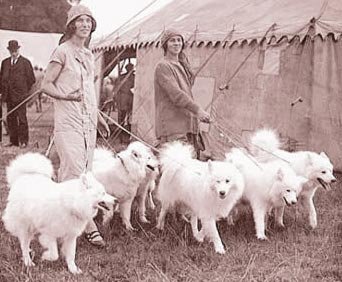
Mrs Kilburn Scott and your Sammys
Mercy d'Argentau was a Belgian princess from Montyglyon who was really passionate for dogs and had several specimens of races which were exhibited at various European fair. In the year 1902 she was in St. Petersburg (Russia). One day when she was leaving a ring she realized that she was being followed by a white dog of extreme beauty. The owner was the Great Duke Michael, brother of Tsar Nicholas II, who was observing that interesting scene and said: "It seems Moustan was delighted with you", and the princess replied "I would pay any amount to have a dog like that but I know very well that it is not for sale”. In the following day, when the princess got on the train that would take her back to Belgium she found a huge basket decorated with roses and orchids. She approached to see what it was and a furry white head appeared among the flowers. It was nothing less than the great Moustan Russian champion. On the collar was the following message: "Moustan is not for sale. No price could be paid for it, but we would be very honored if you accepted it”.
Note: The Samoyeds were introduced in America by England.
Two years later, Mercy d'Argentau moved to the United States of America and brought Moustan and three others Samoyeds that had acquired. The great champion Russian Moustan began participating in dog shows. It was in the year 1906 when the first dog Samoyed breed to be registered in the American Kennel Club (AKC). In 1923, it was created in New York the Samoyed Club of America and the AKC in 1947. These two points in history have generated a remarkable period in which they have developed two morphologically different types of Samoyeds distributed to both ends of the Atlantic, where Kilburn-Scott - named the "bear type " and "wolf type".
The "wolf type" is more robust, more powerful, with more graceful movement, the texture of the hair is harder, the ears are closer, narrower skull, longer snout and less conical head.
The "bear type" is a little smaller in relation to the "wolf", compact, with lots of fur and little volume, strictly conical head, smaller ears and more distant, with more compact movements, often cause lack of credibility in relation to pulling sled.
Nearly exterminated shortly after the fall of the Tsar and when the Communists took power in Moscow. It was believed the rapid development of technology as a way to advance the country in the twentieth century. Arrival of the industrial revolution. Sled dogs symbolized the past should be forgotten, and they were replaced by motor vehicles.
Note: The Samoyeds were introduced in America by England.
Two years later, Mercy d'Argentau moved to the United States of America and brought Moustan and three others Samoyeds that had acquired. The great champion Russian Moustan began participating in dog shows. It was in the year 1906 when the first dog Samoyed breed to be registered in the American Kennel Club (AKC). In 1923, it was created in New York the Samoyed Club of America and the AKC in 1947. These two points in history have generated a remarkable period in which they have developed two morphologically different types of Samoyeds distributed to both ends of the Atlantic, where Kilburn-Scott - named the "bear type " and "wolf type".
The "wolf type" is more robust, more powerful, with more graceful movement, the texture of the hair is harder, the ears are closer, narrower skull, longer snout and less conical head.
The "bear type" is a little smaller in relation to the "wolf", compact, with lots of fur and little volume, strictly conical head, smaller ears and more distant, with more compact movements, often cause lack of credibility in relation to pulling sled.
Nearly exterminated shortly after the fall of the Tsar and when the Communists took power in Moscow. It was believed the rapid development of technology as a way to advance the country in the twentieth century. Arrival of the industrial revolution. Sled dogs symbolized the past should be forgotten, and they were replaced by motor vehicles.
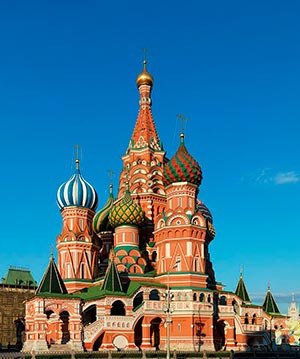
Catedral of S. Basílio,
Red Square.
Red Square.
With touches of cruelty some Russian leaders ordered the slaughter of all the sled dogs. In north places of Russia that order was executed. The dogs were tied to poles outside the town and executed. But because of the extreme difficulty of access to remote places to the north, they failed to exterminate all dogs
There are historians of the race that claim all Samoyeds of nowadays had ancestors and 12 of them were imported just before starting the World War I. These dogs were owned by English breeders who have booked them and took them the exposures. Several of those Samoyeds were veterans of Jackson-Harmsworth expedition in 1894 for Franz Josef Land to the north of the Arctic Circle. One of these dogs, named "Antarctic Buck", was recovered in a zoo in Australia where he had been after having gone to Borchgrevink expedition to the Antarctic, and another Samoyed joined an expedition to the North Pole performed by the Duke of Abruzzi.
Alexander Trontheim provided some Samoyeds to England and others came by English breeders.
The pedigree below dated May 1924, we can see some of the characters mentioned in the story above as Mr. Kilburn Scott and Samoyed called "Antarctic Buck".
Apart from these we can also check the Samoyed called Whitey Petchora (female) and Musti (male), who in 1901 led the first Samoyed litter completely white.
Watch the video "White with Black Points"
There are historians of the race that claim all Samoyeds of nowadays had ancestors and 12 of them were imported just before starting the World War I. These dogs were owned by English breeders who have booked them and took them the exposures. Several of those Samoyeds were veterans of Jackson-Harmsworth expedition in 1894 for Franz Josef Land to the north of the Arctic Circle. One of these dogs, named "Antarctic Buck", was recovered in a zoo in Australia where he had been after having gone to Borchgrevink expedition to the Antarctic, and another Samoyed joined an expedition to the North Pole performed by the Duke of Abruzzi.
Alexander Trontheim provided some Samoyeds to England and others came by English breeders.
The pedigree below dated May 1924, we can see some of the characters mentioned in the story above as Mr. Kilburn Scott and Samoyed called "Antarctic Buck".
Apart from these we can also check the Samoyed called Whitey Petchora (female) and Musti (male), who in 1901 led the first Samoyed litter completely white.
Watch the video "White with Black Points"
